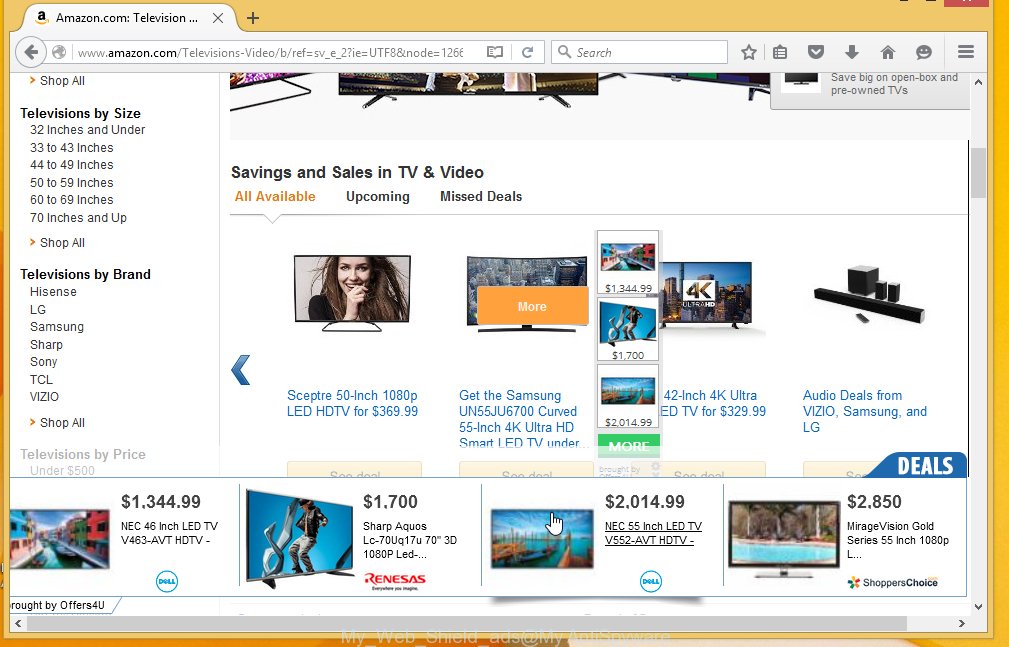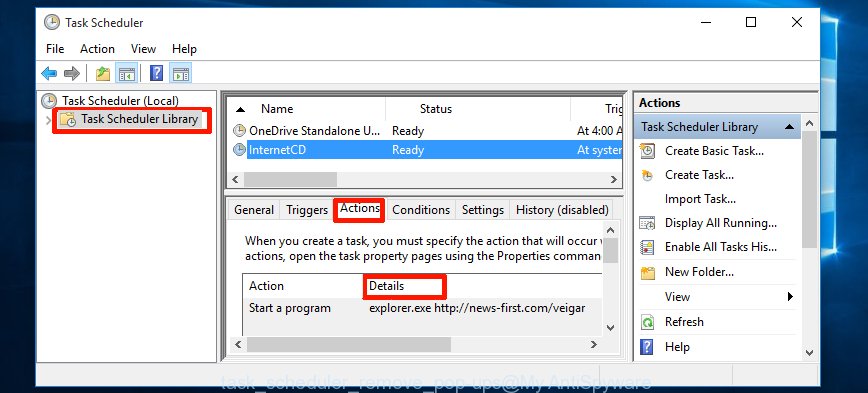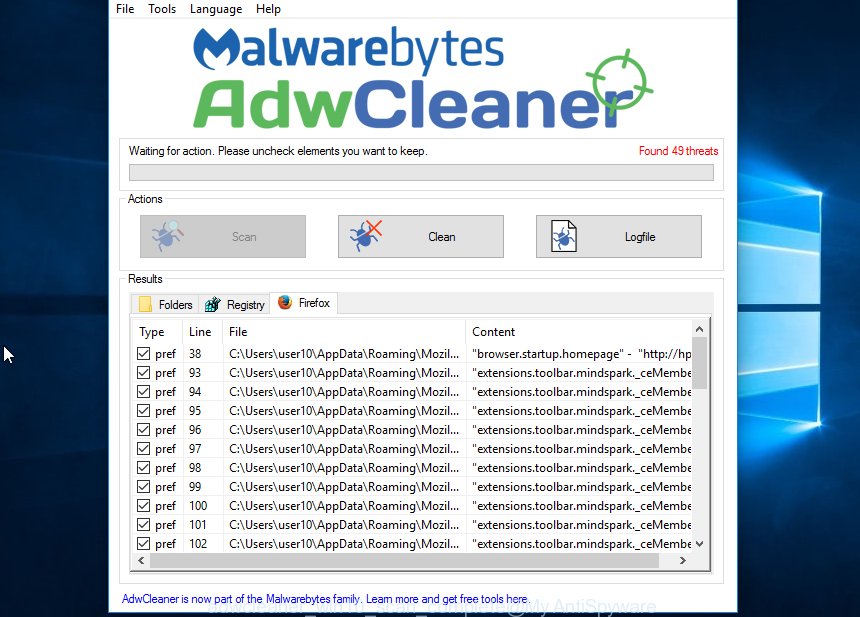The very appearance My Web Shield ads is a classic sign of ‘ad-supported’ software (also known as adware) which installed on your personal computer. Moreover, the ‘ad supported’ software can lead to the web browser freezing/crash, delays when starting a new browser window or delays when viewing a web-site on the Web. I think you definitely want to solve this problem. For this purpose, necessity to perform cleanup of your PC system. You need to follow the step-by-step instructions below that will allow you to remove My Web Shield virus ads and clean your system from the ad supported software using the standard features of Windows and some proven freeware.

Most often, the ad supported software affects the most common browsers like the Google Chrome, Mozilla Firefox, Internet Explorer and Edge. But such the malicious software as well may infect another web-browsers by changing its shortcuts (adding an argument such as ‘http://site.address’ into Target field of a web-browser’s shortcut). So every time you start the browser, it’ll redirect to the unwanted My Web Shield ads. Even if you setup a new start page, an annoying web page will be the first thing you see when you open the Google Chrome, Mozilla Firefox, Internet Explorer and MS Edge.
The ‘ad supported’ software may insert a huge number of ads directly to the pages that you visit, creating a sense that the advertising banners has been added by the creators of the web site. Moreover, a legal advertising banners may be replaced on the fake ads, that will offer to download and install various unnecessary and harmful programs. Moreover, the adware has the ability to collect a lot of personal information about you (your ip address, what is a web page you are viewing now, what you are looking for on the Web, which links you are clicking), which can later transfer to third parties.
Therefore it’s very important to follow the steps below as soon as possible. The guide will assist you to delete My Web Shield adware as well as clean your machine from all unwanted ads. What is more, the few simple steps below will help you delete other dangerous software like unwanted toolbars and browser hijackers, which could penetrate the computer along with the ‘ad supported’ software.
How can you protect your PC system from My Web Shield advertisements
Most often, the adware gets on your PC system as a part of various free applications, as a bonus. Therefore it is very important at the stage of installing programs downloaded from the World Wide Web carefully review the ‘Terms of use’ and the ‘License agreement’, as well as to always choose the Advanced, Custom or Manual installation mode. In this mode, you can turn off all unwanted add-ons, including an adware, which can be installed along with the desired program.
How to manually remove My Web Shield virus ads
Without a doubt, the ad-supported software is harmful to your machine. So you need to quickly and completely get rid of this harmful software. To delete this ‘ad supported’ software, you can use the manual removal which are given below, or use an anti-malware utility for removing malicious programs, such as Malwarebytes Anti-malware and AdwCleaner (both are free). I note that we recommend that you use automatic removal, which will allow you to delete My Web Shield advertisements easily and safely. Manual removal is best used only if you are well versed in PC system or in the case where ‘ad supported’ software is not removed automatically.
- Delete suspicious and unknown software by using Windows Control Panel
- Disinfect the browser’s shortcuts to get rid of My Web Shield redirect
- Remove My Web Shield virus from Chrome
- Delete My Web Shield ads from Firefox
- Delete My Web Shield pop-up ads from Microsoft Internet Explorer
- Remove unwanted Scheduled Tasks
Delete suspicious and unknown software by using Windows Control Panel
First, you should try to identify and remove the program that causes the appearance of annoying ads and web browser redirect to unwanted sites, using the ‘Uninstall a program’ which is located in the ‘Control panel’.
Windows 8, 8.1, 10
Press Windows key

When the ‘Control Panel’ opens, click the ‘Uninstall a program’ under Programs category like below.

You will see the ‘Uninstall a program’ panel as shown on the screen below.

Very carefully look around the entire list of installed applications. Most likely, one or more of them are responsible for the browser redirect to annoying My Web Shield popup ads. If you have many programs installed, you can help simplify the search of malicious software by sort the list by date of installation. Once you have found a suspicious, unwanted or unused program, right click to it and press ‘Uninstall’.
Windows XP, Vista, 7
First, click ‘Start’ button and select ‘Control Panel’ at right panel as shown in the figure below.

When the Windows ‘Control Panel’ opens, you need to click ‘Uninstall a program’ under ‘Programs’ as shown below.

You will see a list of software installed on your personal computer. We recommend to sort the list by date of installation to quickly find the programs that were installed last. Most likely they responsibility for the appearance of annoying pop-ups and web browser redirect. If you are in doubt, you can always check the program by doing a search for her name in Google, Yahoo or Bing. When the application, you need to uninstall, is found, simply press on its name, and then press ‘Uninstall’ as shown in the figure below.

Disinfect the browser’s shortcuts to get rid of My Web Shield redirect
When the ad supported software is started, it can also alter the web-browser’s shortcuts, adding an argument such as “http://site.address” into the Target field. Due to this, every time you launch the web browser, it will be redirected to an annoying ads.
To clear the internet browser shortcut, right-click to it and select Properties. On the Shortcut tab, locate the Target field. Click inside, you will see a vertical line – arrow pointer, move it (using -> arrow key on your keyboard) to the right as possible. You will see a text that starts with “http://” that has been added here. You need to remove it.

When the argument is removed, click the OK button. You need to clean all shortcuts of all your browsers, as they may be infected too.
Remove My Web Shield virus from Chrome
Reset Chrome settings is a simple way to remove the malicious and ad-supported extensions, as well as to restore the browser’s homepage and search engine by default that have been replaced by adware.

- Open the Google Chrome, then click the Menu icon (icon in the form of three horizontal stripes).
- It will open the Google Chrome main menu. Click the “Settings” menu.
- Next, click the “Show advanced settings” link, that located at the bottom of the Settings page.
- Further, press the “Reset settings” button, that located at the bottom of the Advanced settings page.
- The Chrome will open the reset settings prompt as on the image above.
- Confirm the web-browser’s reset by clicking on the “Reset” button.
- To learn more, look the blog post How to reset Chrome settings to default.
Delete My Web Shield ads from Firefox
First, start the Firefox. Next, click the button in the form of three horizontal stripes (![]() ). It will display the drop-down menu. Next, click the “Help” button (
). It will display the drop-down menu. Next, click the “Help” button (![]() ).
).

In the Help menu, click the “Troubleshooting Information”. In the upper-right corner of the “Troubleshooting Information” page, press “Refresh Firefox” button.

Confirm your action, click the “Refresh Firefox”.
Delete My Web Shield pop-up ads from Microsoft Internet Explorer
First, start the Internet Explorer, then click ![]() button. Next, click “Internet Options” as shown on the screen below.
button. Next, click “Internet Options” as shown on the screen below.

In the “Internet Options” screen select the Advanced tab. Next, click the “Reset” button. The Internet Explorer will display the “Reset Internet Explorer” settings dialog box. Select the “Delete personal settings” check box and press Reset button.

You will now need to reboot your computer for the changes to take effect. It will restore the Microsoft Internet Explorer’s settings such as start page and search provider by default to default state, disable ad-supported internet browser’s extensions and thereby delete the reroute to unwanted ad web sites.
Remove unwanted Scheduled Tasks
Once installed, the adware can add a task in to the Windows Task Scheduler Library. Due to this, every time when you run your system, it will display My Web Shield annoying ad web sites. So, you need to check the Task Scheduler Library and remove all tasks that have been created by ‘ad-supported’ programs.
Press Windows and R keys on your keyboard at the same time. It will show a dialog box which called Run. In the text field, type “taskschd.msc” (without the quotes) and click OK. Task Scheduler window opens. In the left-hand side, press “Task Scheduler Library”, as shown on the screen below.

Task scheduler, list of tasks
In the middle part you will see a list of installed tasks. Select the first task, its properties will be display just below automatically. Next, press the Actions tab. Necessary to look at the text which is written under Details. Found something like “explorer.exe http://site.address” or “chrome.exe http://site.address” or “firefox.exe http://site.address”, then you need remove this task. If you are not sure that executes the task, then google it. If it’s a component of the malicious application, then this task also should be removed.
Further press on it with the right mouse button and select Delete as shown in the figure below.

Task scheduler, delete a task
Repeat this step, if you have found a few tasks that have been created by ‘ad-supported’ program. Once is finished, close the Task Scheduler window.
How to remove My Web Shield virus ads with free malware remover
Remove My Web Shield advertisements manually is difficult and often the ad-supported software is not completely removed. Therefore, we recommend you to use the Malwarebytes Free that are completely clean your machine. Moreover, the free program will help you to get rid of malware, browser hijacker and toolbars that your computer may be infected too.
- Download Malwarebytes by clicking on the link below.
Malwarebytes Anti-malware
327016 downloads
Author: Malwarebytes
Category: Security tools
Update: April 15, 2020
- Close all applications and windows on your computer. Open the file location. Double-click on the icon that’s named mb3-setup.
- This will launch the installation of Malwarebytes. Next, press Next button and follow the prompts.
- Once setup is finished, click on the “Scan Now” button to perform a system scan for the My Web Shield adware which redirects your web-browser to unwanted ad pages. This process can take some time, so please be patient.
- Once the scan is finished, make sure all entries have “checkmark” and click “Quarantine Selected”. Once the disinfection is finished, you may be prompted to restart your system.
These steps above are shown in detail in the following video guide.
Block My Web Shield advertisements and other annoying sites
To increase your security and protect your computer against new unwanted advertisements and malicious pages, you need to use program that stops access to dangerous advertisements and web sites. Moreover, the program can block the display of intrusive advertising, which also leads to faster loading of pages and reduce the consumption of web traffic.
Download AdGuard program from the following link.
26828 downloads
Version: 6.4
Author: © Adguard
Category: Security tools
Update: November 15, 2018
Once downloading is finished, start the file named adguardInstaller. You will see the “Setup Wizard” screen like below.

Follow the prompts. Once the setup is finished, you will see a window like below.

You can click “Skip” to close the installation program and use the default settings, or press “Get Started” button to see an quick tutorial which will allow you get to know AdGuard better.
In most cases, the default settings are enough and you do not need to change anything. Each time, when you launch your PC system, AdGuard will start automatically and stop popup ads, ads by My Web Shield, as well as other dangerous or misleading sites. For an overview of all the features of the application, or to change its settings you can simply double-click on the AdGuard icon, which is located on your Windows desktop.
Scan your personal computer and delete My Web Shield virus ads with AdwCleaner.
This removal application is free and easy to use. It can scan and get rid of ad supported software, browser hijackers, malware and unwanted toolbars in Firefox, Google Chrome, Internet Explorer and Microsoft Edge browsers and thereby restore back their default settings (homepage, new tab page and search engine by default). AdwCleaner is powerful enough to find and remove malicious registry entries and files that are hidden on the PC.
Download AdwCleaner tool from the link below. Save it to your Desktop so that you can access the file easily.
225517 downloads
Version: 8.4.1
Author: Xplode, MalwareBytes
Category: Security tools
Update: October 5, 2024
After the download is done, open the directory in which you saved it and double-click the AdwCleaner icon. It will run the AdwCleaner utility and you will see a screen as on the image below. If the User Account Control prompt will ask you want to show the program, click Yes button to continue.

Now, click the “Scan” to perform a system scan for the My Web Shield adware which cause a redirect to ad sites.

When it has finished scanning, it will show a list of all items detected by this utility as on the image below.

You need to click “Clean” button. It will open a dialog box, click “OK” to start the cleaning process. Once the clean-up is complete, the AdwCleaner may ask you to reboot your PC. After reboot, the AdwCleaner will open the log file.
All the above steps are shown in detail in the following video guide.
Finish words
After completing the few simple steps shown above, your system should be free from My Web Shield virus and other malware and ‘ad supported’ software. The FF, Chrome, Internet Explorer and Edge will no longer show unwanted popup ads or redirect you to unwanted web-sites. Unfortunately, if the guide does not help you, then you have caught a new type of ad-supported software, and then the best way – ask for help in our Spyware/Malware removal forum.


















